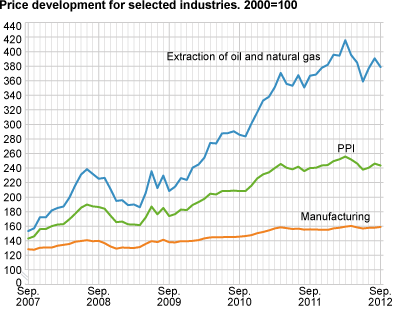Content
Published:
This is an archived release.
Oil price lowered the PPI
The producer price index (PPI) fell by 1.1 per cent from August to September. A fall in prices of crude oil and natural gas pulled the PPI down, while higher prices in refined petroleum products, basic chemicals and electricity helped to mitigate the decline in the overall index.
The main reason for the decrease in the PPI was 3.7 per cent lower prices in extraction of crude oil and natural gas. Prices of crude oil (Brent Blend, measured in NOK) dropped by about 4 per cent from August to September. A decline in prices of natural gas was due to lower prices in the export market, as well as a cheaper US dollar measured against NOK.
Slight price increase in Norwegian manufacturing
The index for manufacturing increased by 0.6 per cent from August to September. The main reason for the inflation in manufacturing was higher prices in refined petroleum products. The prices in this group rose by 2.4 per cent due to higher prices of propane, heating oil and unleaded gas. Aside from the price increase in petroleum products, prices in manufacturing were virtually unchanged. Rising prices in chemical and pharmaceutical products as well as computer and electrical equipment were counterbalanced by lower prices in food products, paper and paper products as well as machinery and equipment.
Higher price in the domestic market
The overall decrease in the PPI in September was largely driven by lower prices in the export market. Price falls in some key export commodities such as crude oil, natural gas, metals and fish had a great impact on the PPI in the export market. With regard to the domestic market, which means goods produced in Norway and sold to Norwegian customers, the prices increased by 0.7 per cent from August to September. Industries that contributed to the increase in the PPI in the domestic market were refined petroleum products, electricity and mining support service activities. Compared with the export market, the crude oil and natural gas had little impact on the domestic market.
Electricity prices increased by 1.7 per cent in September, the second consecutive month with a price increase since the price bottom was hit in July this year. The price increase of electricity was caused by a higher system price in Nord Pool, which was a result of high electricity consumption as well as a decline in Norwegian hydro reservoir levels.
Twelve-month change: PPI up 1.4 per cent
The PPI increased by 1.4 per cent from September 2011 to September 2012. Prices within extraction of crude oil and natural gas, refined petroleum products as well as chemical and pharmaceutical products played a large role in bringing the total PPI up. The price rises in these industries were 2.5, 11.7 and 1.7 per cent respectively. Prices in electricity and basic metals, on the other hand, fell by 19.1 and 8.7 per cent respectively.
| September 2012 | Changes, per cent | ||||||||||||||||||||||||||||||||||||||||||||||||||||||||||||||||||||||||||||||
|---|---|---|---|---|---|---|---|---|---|---|---|---|---|---|---|---|---|---|---|---|---|---|---|---|---|---|---|---|---|---|---|---|---|---|---|---|---|---|---|---|---|---|---|---|---|---|---|---|---|---|---|---|---|---|---|---|---|---|---|---|---|---|---|---|---|---|---|---|---|---|---|---|---|---|---|---|---|---|---|
| August 2012-September 2012 | September 2011-September 2012 | ||||||||||||||||||||||||||||||||||||||||||||||||||||||||||||||||||||||||||||||
| Total index | 243.5 | -1.1 | 1.4 | ||||||||||||||||||||||||||||||||||||||||||||||||||||||||||||||||||||||||||||
| Extraction and related services | 378.9 | -3.0 | 3.2 | ||||||||||||||||||||||||||||||||||||||||||||||||||||||||||||||||||||||||||||
| Manufacturing, mining and quarrying | 159.0 | 0.6 | 2.1 | ||||||||||||||||||||||||||||||||||||||||||||||||||||||||||||||||||||||||||||
| Electricity, gas and steam supply | 186.9 | 1.7 | -19.1 | ||||||||||||||||||||||||||||||||||||||||||||||||||||||||||||||||||||||||||||
| Main industrial groupings | |||||||||||||||||||||||||||||||||||||||||||||||||||||||||||||||||||||||||||||||
| Intermediate goods | 142.5 | 0.4 | -0.3 | ||||||||||||||||||||||||||||||||||||||||||||||||||||||||||||||||||||||||||||
| Investment goods | 129.3 | 0.2 | 1.1 | ||||||||||||||||||||||||||||||||||||||||||||||||||||||||||||||||||||||||||||
| Consumer goods | 133.6 | -0.3 | 0.2 | ||||||||||||||||||||||||||||||||||||||||||||||||||||||||||||||||||||||||||||
| Energy goods | 351.8 | -2.2 | 2.3 | ||||||||||||||||||||||||||||||||||||||||||||||||||||||||||||||||||||||||||||
Additional information
Contact
-
Producer price index
E-mail: produsentpris@ssb.no
tel.: (+47) 21 09 40 00
-
Elisabeth Mælum
E-mail: elisabeth.maelum@ssb.no
tel.: (+47) 97 01 28 49
-
Morten Madshus
E-mail: morten.madshus@ssb.no
tel.: (+47) 40 90 26 94
-
Monika Græsli Engebretsen
E-mail: monika.graesli.engebretsen@ssb.no
tel.: (+47) 40 90 23 71
-
Håvard Georg Jensen
E-mail: havard.jensen@ssb.no
tel.: (+47) 40 90 26 86

